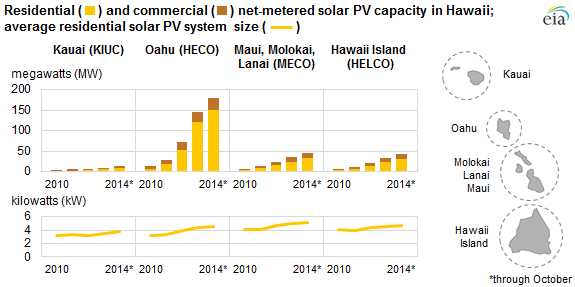The high electricity prices in Hawaii have made wind and solar technologies economically attractive alternatives, especially as their technology costs have come down in recent years.
Hawaii's electric system is changing with rooftop solar growth and new utility ownership
Reprinted with permission from | Today in Energy
In December, NextEra Energy Inc. announced an agreement to acquire Hawaiian Electric Industries Inc., owner of three electric utilities that together supply power to 95% of Hawaii's population. NextEra is one of the largest developers of renewable energy in the United States through its subsidiary NextEra Energy Resourcesand is also the owner of Florida Power & Light (FPL). While FPL does not rely heavily on solar photovoltaics (PV) and other forms of renewable energy to serve its Florida customers, solar PV already plays a large role in Hawaii, and that role is expected to grow significantly over time. The Hawaiian Electric utilities' solar PV programs continue to evolve as the utilities handle ever-larger amounts of customer-sited solar capacity on their small and isolated island grids.

Source: U.S. Energy Information Administration, EIA-861 and EIA-826
Note: Average residential solar photovoltaic (PV) system size calculated by dividing total installed capacity by number of meters. HECO, MECO, and HELCO are subsidiaries of Hawaiian Electric Industries Inc.; KIUC is an independent electric cooperative.
The Hawaiian Electric utilities—Hawaiian Electric Company Inc. (HECO) serving Oahu, Hawaiian Electric Light Company Inc. (HELCO) serving Hawaii Island, and Maui Electric Company Inc. (MECO) serving Maui, Molokai, and Lanai—manage an unusual set of physical assets and operational concerns compared to utilities in the contiguous United States. Unlike other states, Hawaii imports almost all of its energy fuels, and a disproportionate share of Hawaii's electricity comes from oil-fired generators, which is a large part of why Hawaii's electricity prices are the highest in the United States.
The high electricity prices in Hawaii have made wind and solar technologies economically attractive alternatives, especially as their technology costs have come down in recent years. These factors have led to growing wind and solar generation on both the utility scale and in smaller distributed applications—particularly customer-sited rooftop solar PV.

According to EIA's monthly net metering utility data, 9,200 net-metered PV systems were added in 2014 through October, bringing the total number of customers with net-metered PV to around 48,000. In Oahu, where most of the state's population resides, roughly 12% of customers have rooftop solar, compared to an estimated U.S. average of 0.5%, according to the Solar Electric Power Association. The average capacity of residential net-metered PV systems in Hawaii has also been increasing as larger and more efficient PV systems are installed.
Residential solar PV additions have been slowed by the delays customers experienced in getting approval to interconnect new PV systems to the grid. The delays stem from circuits on the Hawaiian Electric distribution grids reaching levels of rooftop PV capacity that are 120% or more of the circuit's daytime minimum load (see maps below)—a key threshold for Hawaiian Electric's interconnection approval process. Once that threshold is passed, an interconnection study may be required before the new PV system can be approved, which has resulted in abacklog of PV applications.
However, Hawaiian Electric recently entered a cooperative research partnership with the National Renewable Energy Laboratory, the Electric Power Research Institute, and SolarCity, one of the largest third-party solar leasing companies in the United States, to study the operational effects of high levels of solar PV on electric grids.Preliminary research results have lead Hawaiian Electric to announce plans to clear its backlog of PV applications by April 2015.
Additionally, as a result of the research, Hawaiian Electric has proposed in a filing made last week to the Hawaii Public Utilities Commission (PUC) to raise the allowable PV penetration threshold from 120% to 250% of a circuit's daytime minimum load. But this change would also be accompanied by a decrease in the amount received by new net-metered PV customers for the excess electricity they send back to the grid. Instead of receiving the full retail rate (about $.30/kilowatthour (kWh) for Oahu residential customers in January 2015), customers would receive something closer to Hawaiian Electric's cost of avoided generation, which largely reflects the cost of purchased fuel. Hawaiian Electric states that the new rate would distribute grid operation costs equitably across solar and nonsolar customers and allow the distributed solar program to be sustainable. Many utilities around the country are similarly engaged in efforts to establish appropriate compensation rates for distributed solar customers while ensuring equitable costs to all customers.
In compliance with orders from the PUC, Hawaiian Electric's proposed plans for the state's long-term energy future also include tripling the amount of distributed solar on its system, procuring energy storage projects (such as batteries) to help balance wind and solar supplies, and converting existing oil-fired power plants to use liquefied natural gas (LNG) that is regasified.
Principal contributor: April Lee
The content & opinions in this article are the author’s and do not necessarily represent the views of AltEnergyMag
Comments (0)
This post does not have any comments. Be the first to leave a comment below.
Featured Product


